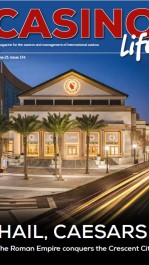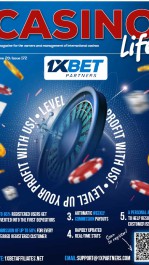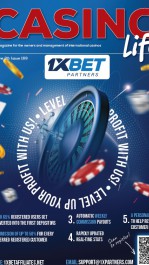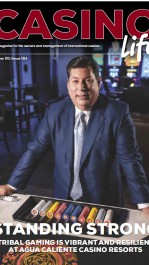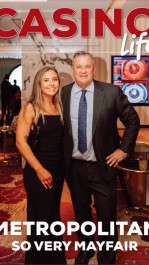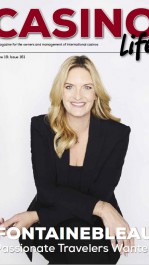Ken Epstein charts the course of the El Cortez Hotel & Casino in Las Vegas. By David McKee
Following in the footsteps of a legend can’t be easy but that is what El Cortez Hotel & Casino CEO Ken Epstein has dared to do. In 2007, he purchased the venerable property from omnipresent Downtown mover and shaker Jackie Gaughan. It’s been Las Vegas’ longest-operating casino since its debut November 7, 1941, a month before Pearl Harbor.

After purchasing the Downtown dowager from the legendary Gaughan, Epstein has balanced keeping the property current and competitive with hewing to its historic roots. Those origins included an early association with mobster Bugsy Siegel, whose presence is commemorated in the property’s signature restaurant. Few casinos can claim to be on the National Register of Historic Places … but there the El Cortez can be found, an honor conferred six years into Epstein’s 17-year tenure.
Neon Museum Executive Director Aaron Berger has hailed the Epstein administration’s commitment to the past saying that “being historically minded, it is no surprise when it comes to their leadership. El Cortez has maintained the integrity of its building for over 80 years. The property has intentionally embraced its past and made updates to meet the needs of today’s visitors without tearing down. That’s unique in Las Vegas, a city known for making way for something new.”

If Jackie Gaughan’s ghost were to roam the halls of the El Cortez today, he would find that his penthouse apartment is now a VIP suite. He would also mourn the demise of his beloved poker room, where he would often sit in on games. But he would find the atmosphere and intimate size still very much to his liking.
The El Cortez formerly sat in splendid isolation, off to one side of the Downtown corridor. But when shoe mogul Tony Hsieh seized on redevelopment with a passion in his Downtown Project, the El Cortez became the terminus of the Fremont East revival. It now sits cheek-by-jowl with happening eateries and bars like The Griffin. Alas, Hsieh died without heirs in 2020, leaving the fate of the Downtown Project very much in flux.
Born the same year as the El Cortez, Epstein — “Kenny” to everyone — was but 18 when he entered the gambling industry, cutting his teeth at the Stardust. The casino industry’s grip on him has not slackened since. A man of few, well-chosen words, the affable Epstein takes up the story of his origins and course to Downtown …
I was born in Chicago and was very fortunate in that my parents moved here in 1959. I went to school in Los Angeles at Santa Monica City College and I wanted to be like my father, a gambler. I spent more time at the racetrack than I should have.
What career path brought you to the El Cortez?
I was working at Caesars Palace as an employee. I went to Lake Tahoe with my parents on a vacation. We saw one of the owners of the Cal-Neva Lodge. He was a friend of my father’s. He said, “I want you to meet a friend of mine who’s got the Tahoe Biltmore,” just across the street. And it was Jackie Gaughan. Jackie was very nice. He took me into the casino, took me around the place, showed me everything. He was really impressive to an 15-year-old.

Later that night we were getting cleaned to up to go to dinner and my father said to me, “You know that fellow that we met today?” “You mean Mr. Gaughan?” “Yeah. He’s a triple threat.” I knew what a triple threat was in football: You can pass. You can run. You can kick. “How is he a triple threat?”, I said. “He’s a go-getter. He’s smart. He’s on the on the square.” Fortunately, I got hooked up with Jackie in 1975, which is 19 years later. How about that?
For those who are unfamiliar with Jackie Gaughan, what was his importance to Las Vegas, and particularly to Downtown?
Jackie was something special. He started the Fun Book, and he owned the El Cortez, Las Vegas Club, the Showboat, the Golden Nugget, the Western, the Plaza Hotel. He had interests in all these hotels. He was Mr. Downtown.

When you joined the El Cortez, in what capacity was it?
I bought five percent in 1975. After that we built the Barbary Coast, the Gold Coast, The Orleans. We had a lot of experience. That was with Jackie’s son, Michael, as well. Jackie said to me, when we sold in 2004, “What are you going to do with this money?” “Jackie, I didn’t get the money yet.” “Well, you will. It’s too much money for you. It’s not good to have that kind of money. Let me give you something to do.” So he sold me the El Cortez.
If he came back today, what aspects of the El Cortez would Jackie Gaughan still find familiar?
It’s changed but it still has the taste of Jackie Gaughan’s operation. We love him and he was a customer’s man. That’s what we are. We’re the owners and we take care of our customers. They know us. This is like a place from the past. There’s no other place like the El Cortez in Las Vegas. All the old places that were here are all gone. All the places with history are all gone.

What are some of the more important changes that you have made?
This tower was built in 1980 and we redid it. It cost almost $25 million, not only because of decor. We had to change all the pipes — stacks of sewer pipes, water pipes and vertical pipes. Plus electricity. An older place, you have to keep it up to code and that will cost you money.
What was important not to change?
The feeling of a place that’s been here a long time. We’re doing a big expansion right now and we wanted to make sure that the architects, the builder and the designer kept it so that it doesn’t feel like it’s brand new, doesn't fit with the rest of the place. We wanted to sort of gradually go into a look like it’s been here.
What are the purposes of the current expansion?
It’s simple. To take care of more customers. We’re just maxed out on the weekends and we don’t have a place to put more people. We’ve got to expand.

How so you expand the casino floor, for instance, in a property that has finite space?
This is space that wasn’t used. It was an old restaurant, a kitchen that’s not in service anymore. That’s the space we’re using.
When the upgrade is finished, what can customers expect to see that is different?
There will be two new bars, a bigger casino space and we’re going to have a new Chinese restaurant. We’ll have a new high-limit area, where bathrooms are for the customers [now].
What is your core audience?
It used to be 70 percent local and 30 percent tourist. It’s switched, absolutely switched now. We used to have $2 blackjack and now we have minimum $15. We used to have a lot of older machines. Now we have all brand-new machines. We’re just upgrading the whole feel of the place.
Value is sort of difficult to explain because you can have the 49-cent breakfast or 99-cent breakfast and free drinks to bring them in. That’s one type of value. Another type of value is charging a nice price, a proper price but not an expensive price, giving them a better experience. Give them value for what they’re getting. It depends on how you look at it. Downtown redevelopment has waxed and waned.

Where does it stand now?
It’s great. First of all we had a gentleman, Tony Hsieh, come to town and he really was great for us. Anybody who spends money in your neighborhood, you gotta love him. He spent over $300,000 buying land here and putting people in business, creating excitement around here. Unfortunately, he’s gone now and we miss him. But he started this rejuvenation of Downtown.
How much of a setback has that been, particularly with Hsieh dying without a will?
It’s not easy because other people want to buy his land and they want to develop it. And it’s not easy because you’ve got to go through all these different lawyerly things. It’s hard to buy a piece of property. Fortunately, we did buy a couple from him, three pieces in fact, and he was a great guy. We’re sorry to lose him. He was a big asset for Downtown.
How is the competitive/collaborative dynamic of Downtown different from elsewhere?
Let me put it this way: Derek Stevens built Circa. Great for us. Great for us! Anybody who spends $700 million, $800 million in your neighborhood, you’ve gotta love it. If you have a house that’s worth X amount of dollars, somebody builds a house that costs 10 times as much next to you, it makes your house worth more. Well, that’s what he did for us.

How closely do you work with the other operators in Downtown?
We don’t work with them all the time but when we’re working on an event. F1 is great for where it’s at. But it blocks up streets and other properties don’t get the benefit of it. So Derek Stevens and the rest of Downtown, we all got together and we’re doing an entertainment venue with food to sort of complement the F1 weekend.
What is the importance of history to you?
We had a gentleman that came to us about 12 years ago. He came to us with an idea. He says, “You’re not playing off your history.” I said, “What do you mean by that?” “Bugsy Siegel, Meyer Lansky and Gus Greenbaum, all gangsters, they owned the place. You’ve got history here. You’ve got the Mob Museum down the street. It must be important because the Mob Museum is catering to the history of Las Vegas and the mobsters that came here. You’ve got ‘em that owned this place. You’re missing the boat!”
So he came up with a plan to rename our restaurant Siegel’s 1941 and he came up with the menu, he came up with pictures — the whole deal. I said, “Great! We’re doing it.” So we did. And he was right. So we’re playing off our history and, in conjunction with the Mob Museum, we have a history hallway here. It shows the history of the El Cortez so it’s pretty good.
What are your ambitions for yourself and the El Cortez as it heads into the future?
I want to stay here as long as I can. I’m only 83, so I’m not giving up. We just want to make this place bigger and better, and my children are partners in this place. If I’m not here anymore they’ll be here.
Casino Life Magazine Team would like to thank Ken Epstein for taking the time for this interview with us earlier this year.
***This exclusive feature interview was originally published in Casino Life Magazines November 2024 edition Issue 171***


